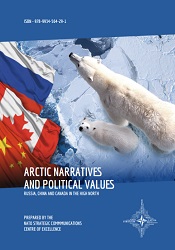ARCTIC NARRATIVES AND POLITICAL VALUES – RUSSIA, CHINA AND CANADA IN THE HIGH NORTH
ARCTIC NARRATIVES AND POLITICAL VALUES – RUSSIA, CHINA AND CANADA IN THE HIGH NORTH
Author(s): Iona Allan
Contributor(s): Elina Lange Ionatamishvili (Editor), Anna Reynolds (Editor)
Subject(s): Politics / Political Sciences, Politics, Economy, Supranational / Global Economy, Environmental and Energy policy, International relations/trade, Security and defense
Published by: NATO Strategic Communications Centre of Excellence
Keywords: Arctic; Russia; China; Canada; global shipping trade; politics; economy; regional access; natural gas; oil; security and defense; political influence;
Summary/Abstract: With almost 30% of the world’s remaining natural gas supply and 13% of oil located under the Northern Polar ice, the Arctic represents a place of great untapped potential.1) After the record-breaking summer ice melts of 2007 and 2012, previously impassable stretches of Arctic waters became ice-free and navigable for the first time. This allowed oil companies to send drilling ships northward and begin the first phases of oil and gas extraction. The decline of Arctic sea ice also significantly impacts the global shipping trade, opening up shorter and more lucrative trade routes between Asia and Europe, and cutting nearly 4000 nautical miles from the route in the process. 2) For Russia and Canada, countries with extensive Arctic shorelines, the receding ice has also exposed significant vulnerabilities in their collective defense and security. Unrestricted passage through their internal Arctic waters means access to Russian and Canadian territory has increased exponentially. For some governments, however, the security risks and grim long-term environmental costs of the melting Arctic ice are dwarfed by the enormity of the short-term economic opportunities on offer. Commercial interests in the Circumpolar North have never been greater. And with such high economic stakes, efforts to secure political influence and regional access to the Arctic have increased dramatically.
- Print-ISBN-13: 978-9934-564-29-1
- Page Count: 35
- Publication Year: 2019
- Language: English
- eBook-PDF
- Table of Content
- Introduction

